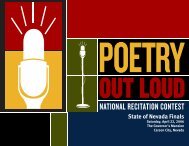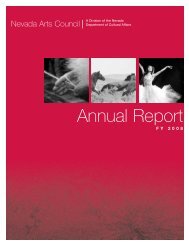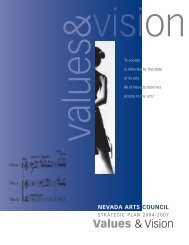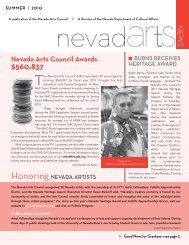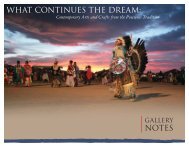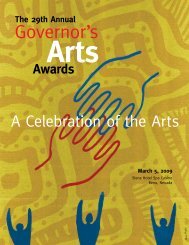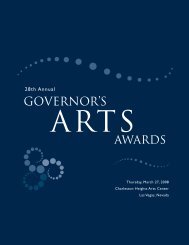Public Art - Nevada Arts Council
Public Art - Nevada Arts Council
Public Art - Nevada Arts Council
You also want an ePaper? Increase the reach of your titles
YUMPU automatically turns print PDFs into web optimized ePapers that Google loves.
12 | Monograph | March 2004<br />
anthropologists, social workers, and the<br />
articulate layperson should all be encouraged<br />
to write and talk publicly about public art<br />
more often.<br />
<strong>Public</strong> artists and program administrators, both<br />
of whom have the greatest involvement and<br />
familiarity with the field, need to gain more<br />
objective critical writing skills to effectively<br />
share their experiences with public art’s larger<br />
audience. <strong>Public</strong> art programs and their parent<br />
agencies should consider partnering with<br />
foundations and the media to support<br />
fellowships for writers and commentators.<br />
Newspapers undoubtedly could do a better<br />
job covering what’s important about public art;<br />
many regard it merely as a photo opportunity<br />
or a human interest story.<br />
Every project has a story to tell, making film<br />
and video and the Internet effective tools for<br />
talking about public art. The complex process,<br />
the many talented artists, and the wide range of<br />
projects can be edited and organized for a broad<br />
audience. We can walk around a sculpture,<br />
observe it during different seasons, hear the<br />
comments of those passing by, and go behind<br />
the scenes.<br />
Television programs such as PBS’s <strong>Art</strong> 21 and<br />
segments occasionally aired on CBS Sunday<br />
Morning are good examples of ways to explore<br />
contemporary art and artists, as they are<br />
accessible to a broad audience and they don’t<br />
“talk down” to viewers. Noteworthy films<br />
include Running Fence, documenting Christo<br />
and Jeanne-Claude’s struggle to install a 22-<br />
mile fabric sculpture in California. More recent<br />
documentaries include the Academy Awardwinning<br />
A Strong Clear Vision about Maya Lin’s<br />
experience creating the Vietnam Veterans<br />
Memorial and other projects, and the 2003<br />
documentary Rivers and Tides about artist Andy<br />
Goldsworthy and his persistent struggle to<br />
create meticulous, fragile, and ephemeral—and<br />
stunningly beautiful—outdoor works of art.<br />
These and other records are tremendous<br />
resources that begin to break down the<br />
language barriers between public art and<br />
its many audiences.<br />
Controversy<br />
<strong>Public</strong> art can become a lightning rod,<br />
especially in complex capital projects,<br />
because it is often the only area where public<br />
participation is invited. <strong>Public</strong> art can also<br />
attract controversy because it uses public<br />
funds and occupies a prominent place in<br />
public spaces. The meaning of great public<br />
art is often not grasped immediately upon<br />
installation; consider the Eiffel Tower, the<br />
Gateway Arch, the Statue of Liberty, and the<br />
Vietnam Veterans Memorial—all controversial.<br />
It wasn’t until years—or even decades—later<br />
that these projects became valued icons, able<br />
to withstand the test of time. It isn’t hard to<br />
offend someone with nudity, political<br />
incorrectness, social commentary, the perceived<br />
unnecessary use of public funds, etc. And<br />
sometimes public art simply doesn’t work.<br />
Let’s face it, there’s plenty of mediocre art out<br />
there, making it difficult to build a case for<br />
future support.<br />
Controversy is a magnet for the media, and<br />
there are plenty of examples. Dennis<br />
Oppenheim’s Blue Shirt project for Milwaukee’s<br />
General Mitchell International Airport faced<br />
overwhelming opposition after the design was<br />
approved by the county’s art committee in 2000.<br />
The monumentally scaled wall-mounted<br />
sculpture of a blue work shirt was the subject<br />
of a legal dispute, based on the fact that the<br />
artist did not complete installation on time.<br />
Oppenheim said the problems with the piece<br />
were not about timing or money, but about<br />
politics. The city government and local press<br />
mounted a campaign against the sculpture,<br />
characterizing it as a pejorative comment on<br />
Milwaukee’s reputation as a blue-collar town.<br />
www.AmericansForThe<strong>Art</strong>s.org



